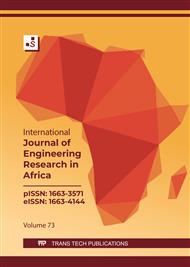[1]
O.M. Ibearugbulem, U.C. Onwuegbuchulem and C. N. Ibearugbulem. Analytical Three-Dimensional Bending Analyses of Simply Supported Thick Rectangular Plate. International Journal of Engineering Advanced Research, (2021), Vol. 3. No. 1 27-43.
Google Scholar
[2]
O.M. Ibearugbulem, J.C. Ezeh, L.O, Ettu and L.S. Gwarah. Bending Analysis of Rectangular Thick Plate Using Polynomial Shear Deformation Theory. IOSR Journal of Engineering, (2018), Vol. 08, Issue 9, pp.53-61.
Google Scholar
[3]
Y. M. Ghugal and A. S. Sayyad. Free vibration of thick orthotropic plates using trigonometric shear deformation theory. Latin American Journal of Solids and Structures, (2011), 8(3), 229–243.
DOI: 10.1590/S1679-78252011000300002
Google Scholar
[4]
R. Vaghefi, G.H. Baradaran and H. Koohkan. Three-dimensional static analysis of thick functionally graded plates by using meshless local Petrov–Galerkin (MLPG) method. Engineering Analysis with Boundary Elements, (2010), Vol. 34, Issue 6, p.564 – 573.
DOI: 10.1016/j.enganabound.2010.01.005
Google Scholar
[5]
K. Rajesh and S. K. Meera. Linear free vibration analysis of rectangular Mindlin plates using coupled displacement field method. Mathematical Models in Engineering, (2016), 1(1), 41-47.
Google Scholar
[6]
F.C. Onyeka. Stability Analysis of Three-Dimensional Thick Rectangular Plate Using Direct Variational Energy Method. Journal of Advances in Science and Engineering, (2022), 1 – 78.
DOI: 10.37121/jase.v6i2.187
Google Scholar
[7]
R.P. Shimpi and H.G. Patel. A two variable refined plate theory for orthotropic plate analysis. International Journal of Solids and Structures, (2006), 43, 6783–6799.
DOI: 10.1016/j.ijsolstr.2006.02.007
Google Scholar
[8]
S. A. Sadrnejad, A. S. Daryan and M. Ziaei. Vibration equations of thick rectangular plates using mindlin plate theory. Journal of Computer Science, (2009), 5 (11), 838–842.
DOI: 10.3844/jcssp.2009.838.842
Google Scholar
[9]
K.O. Njoku, O.M. Ibearugbulem, L.O. Ettu and U.C. Anya. Bending Analysis of Thick Anisotropic Rectangular Plate using Modified First Shear Deformation Theory. International Journal of Innovative Science and Research Technology, (2023) Vol.8, Issue 10, 2456-2165.
DOI: 10.30574/wjarr.2023.20.1.2192
Google Scholar
[10]
A. S. Sayyad. Comparison of various shear deformation theories for the free vibration of thick isotropic beams. International Journal of Civil and Structural Engineering, (2011), Volume 2, No 1, Pp. 85-97.
Google Scholar
[11]
L.Caterina. Elastic constants determination of anisotropic materials by depth-sensing indentation. SN Applied Sciences, (2019), Vol. 1, 1263 |.
DOI: 10.1007/s42452-019-1301-y
Google Scholar
[12]
P. Plucinski, J. Jaskowiec and M. Wojtowicz. Three-dimensional Bending Analysis of Multi-Layered Orthotropic Plates Two-Dimensional Numerical Method. Materials, (2021), Vol. 14, Issue 22.
DOI: 10.3390/ma14226959
Google Scholar
[13]
S. Srinivas and A.K. Rao. A Three-dimensional Solution for Plates and Laminates. Journal of the Franklin Institute, (1971), Vol. 291, No. 6, p.469 – 481.
DOI: 10.1016/0016-0032(71)90004-4
Google Scholar
[14]
L. Zhao, M. Wang, R.Yang, M. Zhao, Z. Song and N. Bohlooli. Using Three-Dimensional Theory of Elasticity for Vibration Analysis of Laminated Sectorial Plates. Steel and Composite Structures, (2023), volume 48, Number 1, pp.1-17.
Google Scholar
[15]
R. Sburlati. Three-Dimensional Analyses of Functionally Graded Multi-Layered Systems. Procedia Engineering, (2014), Vol. 88, p.235 – 241.
DOI: 10.1016/j.proeng.2014.11.150
Google Scholar
[16]
P. Zhang, C. Qi, H. Fang and W. He. Three dimensional mechanical behaviors of in-plane functionally graded plates, Composite Structures (2020), Doi: https://doi.org/10.1016/j.compstruct. 2020.112124.
DOI: 10.1016/j.compstruct.2020.112124
Google Scholar
[17]
F.C. Onyeka, B.O. Mama, and T.E. Okeke. Exact Three-Dimensional Stability Analysis of Plate Using a Direct Variational Energy Method. Civil Engineering Journal, (2022), Vol. 8, No. 1, pp: 60-80.
DOI: 10.28991/CEJ-2022-08-01-05
Google Scholar
[18]
H.Y. Sarvestani, A. Naghashpour and M. Heidari-Rarani. Bending analysis of a general cross-ply laminate using 3D elasticity solution and layer wise theory. Int J Adv Struct Eng, (2015) 7:329–340b.
DOI: 10.1007/s40091-014-0073-2
Google Scholar


